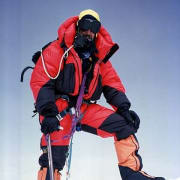Legendary Alpinist Plans First Alpine-Style Winter Ascent on Manaslu

Alpine-Style Winter Ascent on an 8,000-meter Peak
The Himalaya, the highest mountain range in the world, stretches across Nepal, India, Bhutan, China, and Pakistan. The range is home to the fourteen 8,000-meter peaks - the highest mountains in the world. Among these giants stands Manaslu. Manaslu, located in the Mansiri Himal range of the Nepalese Himalayas, stands 26,781 ft. - making it the 8th highest mountain in the world. Known as the "Mountain of the Spirit," Manaslu is a prominent and revered peak targeted by elite climbers. One such climber, legendary alpinist Simone Mora, has set his sights on a ‘winter climb’ on Manaslu, during the most treacherous and difficult time of year in the Himalaya. (Manaslu - Related Article)
Climbing season in the Himalaya takes place twice per year when the Jetstream subsides above the Himalayan sky. This brief calm, known as the 'weather window', or ‘climbing window’, first occurs in the spring from March to early June. A second ‘weather window’ opens during the post-monsoon season, from early September through mid-December. This fall’s climbing season has witnessed great success on several Himalayan peaks – including Manaslu. Simone Mora’s ambitions plan extends beyond this fall window, and into the abyss of deep winter. He will attempt an 'astronomical winter’, ‘alpine-ascent style’ climb of an 8,000-meter peak – something never-before accomplished.
Nima Rinji Sherpa
Simone will not be alone on this historic attempt. While a full team has not been announced, Mora has tapped Nima Rinji Sherpa to join him. Nima Rinji Sherpa made history last week when, at 18-years old, he became the youngest person to summit all fourteen 8-meter peaks. Angela Benavides recently caught up with Simone Mora and reported on his plan in an article for ExplorersWeb. After summiting Ama Dablam, Moro explained why he decided to invite the young Nepalese mountaineer.
“I want to help Nima Rinji become a future professional mountaineer. Sherpas are strong, but they are either guides or porters, because they have to combine their wish to do technical climbs with earning money. I want to give him the right training. He is already a strong climber, so let’s try to make him a technical alpinist too.”
This training will take place on Mora’s 6th attempt on Manaslu during the most difficult time of year, to perform a ‘winter alpine-style’ ascent on the 8,000-meter peak. Mora is a purist. Consequently, he will apply the terms ‘alpine-style’ and ‘winter’ in the most literal fashion. So, what does this mean?
‘Alpine-style’ climbs dictate that mountaineers climb without Sherpa support, supplemental oxygen, previously established camps or gear caches, or fixed ropes. Such support is standard on most Himalayan expeditions. Further, a technical interpretation of an ‘alpine-style’ ascent requires ascending the mountain in a single-push. Japanese climbers Yamada and Saito successfully made a winter ascent on Manaslu in 1985 but, as Mora points out, failed to make an ‘alpine-ascent’.
“That fantastic climb of Yamada and Saito happened December 14, 1985 on their second attempt of that season. On the 9th of December, they stopped at 7,200m and returned to Base Camp for a rest. Then they launched a second summit push that succeeded on December 14. Alpine-style doesn’t allow any prior attempt on the same route in the same season.”
Attempting to Make History
The successful Japanese climb, while at a difficult time of year, also did not pass the test as truly a ‘winter’ climb. It didn’t meet the requirement as an ‘astronomical winter climb’ – a distinction not lost on Mora. The astronomical/ calendar winter starts on December 21st each year. Therefore, a climb cannot begin until this date to be considered a true ‘winter’ climb. Tough standards, but parameters the legendary Italian climber honors, and will adhere to. Simone Moro and Nima Rinji’s alpine-style winter attempt, should they succeed in the truest interpretation of the style and timing, will make history – the first such summit on an 8,000-meter peak.
